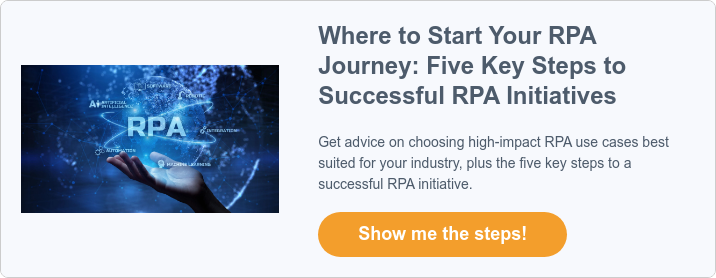RPA can be a powerful, effective tool to help you accomplish your digital transformation goals. However, RPA projects can fail with the wrong approach.
To ensure your RPA implementation produces long-lasting results and scales, you need to be aware of common RPA mistakes that can lead to failure.
Top 5 RPA Mistakes and How to Avoid Them
1. Automating the Wrong Processes
Just because you can automate it doesn’t mean you should. RPA is known to produce impressive ROI, but this potential quickly fades if you automate the wrong processes. A common mistake is to apply RPA to processes that are incredibly complex, non-standardized, and possess over 40% exceptions. These processes typically need human judgement and are inconsistent in their labor requirements.
How to Avoid It
Some processes make better RPA use cases than others, so it’s important to carefully examine your processes to get the most out of your RPA investment. Then, to identify your best RPA opportunities, involve the input of both your IT staff and business analysts. We suggest you search for processes that have multiple of the following traits:
- Manual
- Prone to error
- Does not require human judgement
- Time-consuming
- Time-sensitive
- High-volume
- Repetitive and tedious
- Rule-based
- Constant over time
- Handles a high volume of transactions
- Has easily accessible test data
- Low exception rates
- Involved with sensitive data
- Impacts the bottom line
2. Unrealistic Expectations and Timelines
It’s crucial to approach RPA with realistic expectations. Setting unrealistic goals can cause you to prematurely conclude that your initiative has failed. Additionally, if you rush your RPA project, you won’t have time to strategically design, test, and fine-tune your RPA environment, a recipe for disappointment.
How to Avoid It
During the planning and implementation phases, take your time and start with a clearly defined set of objectives. Before running a proof of concept, conduct a thorough evaluation of how automation can help you tackle your business challenges. Consider your business priorities to ensure you’re applying RPA to those that matter most. Give yourself plenty of time to craft realistic goals and put measures in place to reach them. Building your infrastructure with care will allow you to align your solution with your goals, increasing your chances of reaching them.
At times, it’s best to start your RPA journey with a use case that’s likely to produce tangible results. Starting small not only gives you valuable early experience to help you tackle bigger initiatives but can build momentum and increase buy-in.
3. Lacking a Long-Term Plan with Strong Governance
Don’t let your RPA investment be a one-time investment. Without sufficient planning far into the future, you can miss out on many of RPA’s benefits, and scaling will be nearly impossible. Another common RPA mistake is failing to implement a strong governance, a team of people from across your organization dedicated to the success of your RPA investment. This mistake can be especially detrimental, with CIO.com naming it the single largest driver of value accretion in RPA. And without a strong project management team behind you, it will be hard to stay on track and reach your goals.
How to Avoid It
To ensure your RPA solution benefits you far into the future, you need a clearly defined strategy that outlines the process’ unfolding and evolution over time. Consider the potential effects the solution will have on all levels of your organization. Then, construct a realistic plan that accounts for months and years past initial implementation.
You will also need to assemble an RPA Center of Excellence (CoE) that unites internal professionals from various areas of expertise. Their diverse knowledge and perspectives will be valuable in all phases of your RPA journey. It’s their job to pay attention to your solution’s costs and benefits and make adjustments as needed to help you get optimal results and scale. With a strong CoE and experienced project management team on your side, you’ll have the support and oversight necessary for RPA success.
Watch the video below to get some beginner’s must-have tips on building an RPA strategy from Tom Taulli, Forbes contributing author and author of “Artificial Intelligence Basics: A Non-Technical Introduction” and “The Robotic Process Automation Handbook: A Guide to Implementing RPA Systems.”
Tips for Building a Strategy for RPA, Process Mining, and AI4. Insufficient Training for Bots and Employees
When it comes to RPA bots, you can’t just set it and forget it. Too often, organizations only provide training to their bots for a short period at the beginning of implementation. While RPA bots are highly capable of working completely independently without error, they require some guidance in the early stages and light maintenance throughout their lifetimes.
Organizations also regularly fail to educate their employees about the proper way to use RPA bots. Since bots make creating new code easier than ever, employees may begin trying their hand at this task traditionally reserved for a project team. This extension increases the risk of shadow deployments, negatively affecting your cybersecurity and operations. It can even snowball a task’s complexity until the process is more complicated than its manual form.
How to Avoid It
Plan to offer multiple training sessions until your bot is ready to navigate any situation it comes across. However, even when your bot is well seasoned, there will likely be environmental shifts that call for updates. You can think of your bots as digital employees. Sure, they work tirelessly without error around the clock, but they still need some “continued education” for continued optimal performance.
To ensure your employees know how to use bots responsibly, structure training sessions early on. Educate them on how to correctly measure, log, and monitor the development and performance of bots. Additionally, help them understand the conditions that make a process RPA-suitable. This way, you can avoid counterproductive RPA deployments.
5. Failing to Produce a Thoughtful, Strategic Design with the Right Input
Your RPA project is only as good as you set it up to be. Unfortunately, another common RPA mistake is failing to create a strategic design. Many implementations focus on getting the project off the ground as soon as possible, causing them to jump into software configuration without a well-developed design.
Many organizations also fail to get the right input from the right parties. Some strictly focus on the technical side of things. This exclusion is detrimental to RPA success because RPA implementation isn’t just a technology project. It’s a business initiative that affects the entire enterprise. Other organizations lean in the other direction, leaving the IT team in the dark for most of the planning and implementation process. This imbalance denies the implementation of critical technical expertise in data security, the current IT infrastructure, and more.
How to Avoid It
Thorough, thoughtful design is vital to a strong RPA deployment, so it’s worth investing in plenty of time and resources to get it right. As previously discussed, take your time prioritizing and identifying processes best fit for automation.
Considering the ripple effect of automation is another often neglected component of design planning. Most of your processes affect and are affected by other processes. Each step responds to the processes that trigger them, and their output impacts the following steps. As a result, when you automate a task with RPA, you must consider all possible outcomes it may have on other steps of the overall process and other processes.
Additionally, when building your RPA team, it’s important to strike a balance between the technical and the non-technical. Perspectives from both sides are critical to forming a thoughtful, clean design that factors into your organization’s broader business goals and long-term digital transformation vision.
Skip to the Good Part
With thoughtful, strategic planning, the right minds, and knowledge of the lessons other organizations have learned the hard way, you can avoid the common pitfalls of RPA and reach your goals.
Want More Content Like This?
Subscribe to the Naviant Blog. Each Thursday, we’ll send you a recap of our latest info-packed blog so you can be among the first to access the latest trends and expert tips on workflow, intelligent automation, the cloud, and more.







